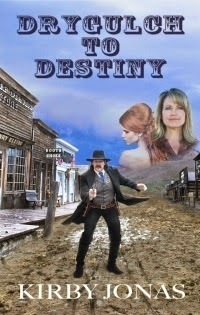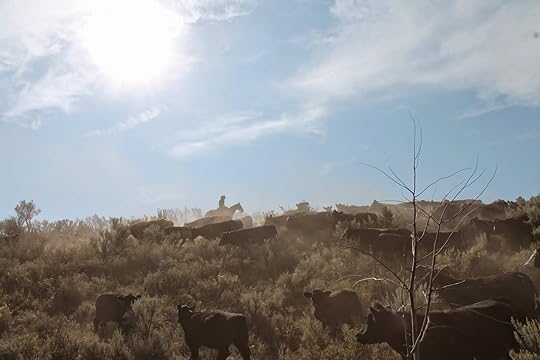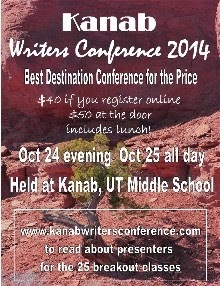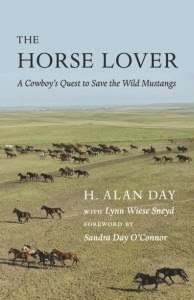Rod Miller's Blog, page 38
September 19, 2014
Odds and ends, bits and pieces.

Not long ago I finished reading Drygulch to Destinyby Kirby Jonas. I’ve known Kirby for several years through Western Writers of America, but only recently learned we once lived in the same small town in Idaho (although he is much younger than I) and he took ag classes from my brother, who taught at the high school there. All that aside, it’s a big, sprawling novel about a town tamer tortured by past accusations and challenged by lawless toughs in a mining boomtown. It’s a darn good story and well worth a read. (http://kirbyjonas.com/)

Speaking of Idaho, I recently spent a weekend there working on an article for Ranch & Reata magazine. The subject of the story is a remarkable young lady named Kimberlyn Fitch. She’s an oft-decorated rodeo champion, breeds show cattle, puts in her time at the ranch, and is studying to become a nurse. That’s her on the skyline in the photo above, gathering cows along a ridge above Midnight Creek. I’ll be back in Idaho soon to conduct a couple of workshops at the Idaho Writers League’s annual conference. A month or so later, I’ll be presenting at the Kanab Writers Conference (http://kanabwritersconference.com/) in southern Utah, and signing books at the Read Cat Bookstore.

But for now, it's back to work.
Published on September 19, 2014 09:12
September 9, 2014
Guest Post: Lessons from the Poets.

Lynn Wiese Sneyd of LWS Literary Services—a firm which provides a variety of marketing and publicity services for authors—kindly asked me to contribute a guest post to her site. The post goes online today. It’s titled “Three Things We Can Learn from Poets” and talks about a few literary techniques employed by poets and how writers of prose can employ those tools to improve what they write. Read my contribution here, http://lwsliteraryservices.com/blog/, and be sure to check out the rest of Lynn’s web site to access a whole bunch of interesting and helpful information.The ideas in my guest post are condensed from an in-depth treatment of the subject I will present in late October at the Kanab Writers Conference. (More about that later.)
And now a word from our sponsor.

My new collection of poetry, Goodnight Goes Riding and Other Poems, is now available from Pen-L Publishing. (!) It’s available exclusively from the publisher until the end of the month, when it will go into wider distribution to all the usual places that sell books.Until then, Pen-L is offering the book at a 15% discount, saving all you early purchasers some money. Follow this link for this special, limited offer: http://Pen-L.com/GoodnightGoesRiding.html.
Published on September 09, 2014 04:56
August 31, 2014
Lies They Tell Writers, Part 4: Find Your Voice.

Call me an idiot, but I have never understood the admonition to writers to “find your voice.” What does it mean, anyway?First of all, if there is such a thing as a “voice” how can you not have one? Then, assuming you do have a “voice,” why would you want only one?Now, if you are a columnist or commentator, I can see how you would want to develop a particular, recognizable writing style. And if you’re writing a memoir or autobiography, it certainly ought to read—sound—like the whole thing comes from the same pen (mouth?). But if you’re writing a magazine article for, say, Cosmopolitan, it certainly should not sound the same as a story you’re writing for True West. There, it seems the “voice” should be that of the publication and the story. And you wouldn’t want your Old West romance novel to read like your modern-day mystery novel. In fiction, it seems it’s the characters who ought to have “voices,” not the author. Each poem, each song, each short story likewise should speak for itself, in whatever “voice” best tells the story. Of course I could be wrong, lacking as I am in a literary education. But when it comes to finding my “voice,” I don’t even know where to look.
Published on August 31, 2014 18:23
August 24, 2014
Swapping horse stories with Alan Day.

A few years ago, H. Alan Day co-authored the ranch memoir, Lazy B: Growing up on a Cattle Ranch in the American Southwest, with his sister, Sandra Day O’Connor. Not long ago, he wrote The Horse Lover: A Cowboy’s Quest to Save the Wild Mustangs. It’s the story of how he built Mustang Meadows Ranch, the first government-sponsored wild horse sanctuary established in the United States. In addition, the book relates a wealth of stories about the author’s lifelong love of horses, with tales of his adventures and misadventures. I was asked to review the book for Roundup Magazine and I wrote, among other things, “Those who don’t know horses will find this book an engaging introduction. Readers who do will find themselves nodding in understanding page after page.” I had the pleasure of meeting Alan Day at the Western Writers of America convention a few months ago. He’s a cowboy through and through and as nice a guy as you’ll ever meet. He asked me to write a little something about horses for his web site (http://thehorselover.com). At the site, you’ll learn more about Alan and his remarkable book, The Horse Lover. My “guest” post is here: http://thehorselover.com/blog/.Stop by and visit Alan Day. He’d love to swap horse stories with you.
Published on August 24, 2014 06:30
August 19, 2014
Going to see Jeff Wolf’s “Rodeo.”

Last week I took a road trip to Idaho to visit the Gooding County Fair and Rodeo. The photograph above is the reason why. That’s Jeff Wolf, a man I have known since we were boys. For many years now, Jeff has been a Western sculptor of some renown. His work is on display in several galleries, museums, homes, and other places around the West. (Visit www.jeffwolfstudios.com.)His latest piece of public art is the monumental sculpture at this side. It’s called “Rodeo,” a remarkable sculpture featuring bareback, saddle bronc, and bull riders and their mounts intertwined in a beautiful dance. The action and motion captured in the statue are remarkable—looking at the cold bronze you can almost feel the hot breath and hear the slap of leather and smell the dust. Jeff and the making of “Rodeo” will be featured in an article I wrote for an upcoming issue of Ranch & Reata magazine (www.ranchandreata.com). Watch for the magazine. And next time you’re in the neighborhood, stop by the Gooding County Fairgrounds and see “Rodeo” first hand.
Published on August 19, 2014 05:27
August 10, 2014
Lies They Tell Writers, Part 3: Writer’s Block.

Sometimes you just can’t do it. You try, but there’s nothing there. You stare and stare at an empty page or blank screen and it just stares back at you. And the more you think about it, the more you worry, the worse it gets.Writer’s block, they call it. Some folks in the literary business bemoan the fact that such an affliction can befall would-be writers. Then they devise all sorts of remedies and exercises to rid you of the malady: Go for a walk. Change your routine. Consume caffeine. Do something else, instead. Try free writing. Or visualization. Whine about it to fellow writers. And so on. Some of the best writers I know don’t believe in writer’s block. And if they do, they ignore it and write anyway. It’s probably no coincidence that many who pay writer’s block no mind come from journalism or advertising or other disciplines where deadlines are an everyday occurrence. When something has to be written, it’s your job to write it. So you do. You collect your thoughts (quickly), fire up the computer, and clack away at the keys until you’ve finished writing, rewriting, and revising the work at hand. Then you turn it in and get on to the next job. Whether it’s an advertising agency, a newspaper, a public relations firm, a magazine, a marketing department, or any number of other places were your job is to write and getting paid depends on doing the job, there’s just no time for the angst and anxiety and anguish (and absurdity) of writer’s block. And what you learn by writing on demand carries over to writing in what may be less demanding circumstances—a novel, say. Or a short story. A poem. A magazine article. A biography. You write. Assuming there is such a condition as the dreaded writer’s block, there can only be one cure for it: get to work. Write.
Published on August 10, 2014 13:22
August 2, 2014
Lies They Tell Writers, Part Two: Develop a Routine.

Set aside a time, a place, a situation for writing. Immerse yourself in the appropriate milieu for motivation. It might be a certain style of background music, or maybe it’s silence. Brightly lit, perhaps, or softly illuminated. Have your favorite thesaurus at hand, and align the proper number of freshly sharpened number two pencils. But whatever you do, however you do it, you must—must—create an environment that turns your attention inward and focuses your concentration on your art; an ambience that filters out distractions and informs your mind and body that it’s time to write. That’s the kind of thing I've heard over and over again about how to write. It might work for some. Maybe. But why limit your ability, your opportunities, to write to a certain confined situation? Why not write anywhere, anytime? I have written while all by myself and when surrounded by family. In private and in public. At desks and at kitchen tables. Indoors and outside. In offices and airports and hotel rooms. On a computer. A notepad. A scrap of paper. With and without music and while sitting in front of the TV or listening to the radio. In bed, on the couch, on the porch, at the library, in restaurants, on the bus. If I’ve spent any time there, chances are I’ve written something there. Manufactured surroundings and invented schedules might sound like an effective way to free yourself to write. On the other hand, such machinations may prove so confining, so restrictive, they smother the muse. It might work for some. It may even work for you. But, despite what proponents of predictability preach, it ain’t necessarily so. Instead, write. Just write. Wherever and whenever the opportunity arises. The words don’t care.
Published on August 02, 2014 07:48
July 26, 2014
Lies They Tell Writers, Part 1: Write What You Know.
 You hear it all the time at writer’s workshops: write what you know.I don’t believe a word of it. Writing about what you know about seems to me a recipe for repetition and stagnation. Instead, write what you want to know. The best writers are inherently curious, always seeking—through reading or travel or whatever—to learn something new. You could call it research. And those new things, whether sought out deliberately or stumbled upon by serendipity, often find their way into a story, a song, a poem, or a book—usually after considerably more research and curiosity.Now, this is not to say you shouldn’t develop some mastery of the subject—know it, in other words—before you write about it. For one thing, readers who do know can spot a phony from afar. For another, writers owe readers a heaping helping of honesty, truth, and reality along with entertainment. And that’s true whether you’re writing fiction or nonfiction, poetry or plays, essays or songs, movies or magazine articles. Texas poet Larry D. Thomas would never have imagined The Goatherd had he not been curious about what life might have been like for a man who tended goats in long-ago Texas. Michael Zimmer would not have written the outstanding novel Beneath a Hunter’s Moon had he not wondered about the somewhat obscure Métis and their ways. We would not have South Pass had Will Bagley not set out to discover the finer points of exploration and emigrant travel over the Continental Divide’s easiest crossing. And so on.Don’t let your writing be limited by the limits of your knowledge by believing the lie that you should write what you know. Learn something new. Then, you’ll come to know what you write—and so will your readers.
You hear it all the time at writer’s workshops: write what you know.I don’t believe a word of it. Writing about what you know about seems to me a recipe for repetition and stagnation. Instead, write what you want to know. The best writers are inherently curious, always seeking—through reading or travel or whatever—to learn something new. You could call it research. And those new things, whether sought out deliberately or stumbled upon by serendipity, often find their way into a story, a song, a poem, or a book—usually after considerably more research and curiosity.Now, this is not to say you shouldn’t develop some mastery of the subject—know it, in other words—before you write about it. For one thing, readers who do know can spot a phony from afar. For another, writers owe readers a heaping helping of honesty, truth, and reality along with entertainment. And that’s true whether you’re writing fiction or nonfiction, poetry or plays, essays or songs, movies or magazine articles. Texas poet Larry D. Thomas would never have imagined The Goatherd had he not been curious about what life might have been like for a man who tended goats in long-ago Texas. Michael Zimmer would not have written the outstanding novel Beneath a Hunter’s Moon had he not wondered about the somewhat obscure Métis and their ways. We would not have South Pass had Will Bagley not set out to discover the finer points of exploration and emigrant travel over the Continental Divide’s easiest crossing. And so on.Don’t let your writing be limited by the limits of your knowledge by believing the lie that you should write what you know. Learn something new. Then, you’ll come to know what you write—and so will your readers.
Published on July 26, 2014 07:14
July 20, 2014
Did you know?

The manuscript for The Lost Frontier: Momentous Moments in the Old West You May Have Missed just went out to the publisher (Two Dot/Globe Pequot). It will be on bookshelves sometime next year, and I will let you know when. It’s a nonfiction book, each chapter of which addresses an incident or event or person or place that was important in the history and development of the Old West, but is largely forgotten today. And a lot of it flies in the face of what you learned in school. It was a fun book to research and write, and I learned a lot in the process. I hope readers will, too. For example, did you know that Lewis and Clark were not the first to cross the North American continent? Or that the United States and England almost went to war over a pig?Did you know a Texan may have taken to the air long before the Wright brothers?Or that America was once ruled by an emperor?All these and many other stories are told in The Lost Frontier. I can’t wait to read it.
Published on July 20, 2014 18:17
July 15, 2014
Thinking about success in the rodeo arena.

Not long ago I wrote about a friend from my college rodeo days, Bruce Hunt, who recently retired after a long career as a rodeo coach at West Hills College. One of his success stories as a coach was his daughter Nora, whose accomplishments in high school, college, and professional rodeo are immense. While she still ropes, Nora Hunt-Lee is married, raising two kids, and working as a clinical psychologist, therapist, and family counselor. Part of her practice is Sports Psychology, with an emphasis on helping rodeo athletes. You can read all about Nora—her accomplishments, her practice, and her philosophy of achievement—in the latest issue of Ranch & Reatamagazine (www.ranchandreata.com). It’s an interesting article, and it was a pleasure to work with Nora to put it together. And while this is a simplistic summary, it turns out that success in rodeo—like in a lot of life—is all in your head. I wish she had been around when I was crawling down into the chute….
Published on July 15, 2014 04:49



